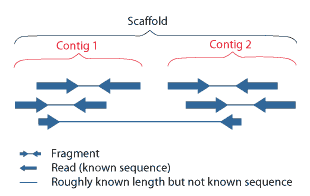|
Nippostrongylus Brasiliensis
''Nippostrongylus brasiliensis'' is a gastrointestinal roundworm that infects rodents, primarily rats. This worm is a widely studied parasite due to its simple lifecycle and its ability to be used in animal models. Its lifecycle is similar to the human hookworms ''Necator americanus'' and ''Ancylostoma duodenale'', taking five molting stages to become sexually mature. Lifecycle Eggs located within the soil release motile, free-living worms that must moult twice (L1 and L2) to develop into their infective L3 stage. This L3 stage can penetrate through intact skin in as little as 4 hours. Once inside the host, the worms invade the venous circulation and are carried into the lungs, where they become trapped in the capillaries. When the worms mature into the L4 stage, they rupture the capillaries and are released into the alveoli, where they are coughed up and swallowed. They then reach the small intestines 3–4 days after the initial infection. The worms become adults after the fin ... [...More Info...] [...Related Items...] OR: [Wikipedia] [Google] [Baidu] |
Lauro Pereira Travassos
Lauro Pereira Travassos (2 July 1890 – 20 November 1970) was a Brazilian parasitologist. He collected helminth specimens from across South America and studied their life-histories. He built a Brazilian school of parasitology through his students. His son Lauro Pereira Travassos Filho (1918–1989) became an entomologist while another son Haroldo Pereira became an ichthyologist. Travassos was born in Angra dos Reis. He studied medicine at Rio de Janeiro and his first work was on ''Linguatula serrata'' in the intestine of a patient. His doctoral thesis was on species of Heterakinae. He then worked at the Instituto Oswaldo Cruz which was then called the Manguinhos under José Gomes de Faria. He became chair of parasitology at the faculty of medicine in São Paulo in 1926. In 1929 he went to the tropical institute of Hamburg to work with the helminthologist Friedrich Fülleborn Friedrich Fülleborn (September 13, 1866 – September 9, 1933) was a physician who specialized in tropi ... [...More Info...] [...Related Items...] OR: [Wikipedia] [Google] [Baidu] |
Tetramisole
Levamisole, sold under the brand name Ergamisol among others, is a medication used to treat parasitic worm infections, specifically ascariasis and hookworm infections. It is taken by mouth. Side effects may include abdominal pain, vomiting, headache, and dizziness. Use is not recommended during breastfeeding or the third trimester of pregnancy. Serious side effects may include an increased risk of infection. It belongs to the anthelmintic class of medications. Levamisole was invented in 1966 in Belgium by Janssen Pharmaceuticals. It is on the World Health Organization's List of Essential Medicines. Levamisole is also used as a dewormer for cattle. Medical uses Worms Levamisole was originally used as an anthelmintic to treat worm infestations in both humans and animals. Levamisole works as a nicotinic acetylcholine receptor agonist that causes continued stimulation of the parasitic worm muscles, leading to paralysis. Levamisole has gained prominence among aquarists as an ... [...More Info...] [...Related Items...] OR: [Wikipedia] [Google] [Baidu] |
Parasites Of Rodents
Parasitism is a close relationship between species, where one organism, the parasite, lives (at least some of the time) on or inside another organism, the host, causing it some harm, and is adapted structurally to this way of life. The entomologist E. O. Wilson characterised parasites' way of feeding as "predators that eat prey in units of less than one". Parasites include single-celled protozoans such as the agents of malaria, sleeping sickness, and amoebic dysentery; animals such as hookworms, lice, mosquitoes, and vampire bats; fungi such as honey fungus and the agents of ringworm; and plants such as mistletoe, dodder, and the broomrapes. There are six major parasitic strategies of exploitation of animal hosts, namely parasitic castration, directly transmitted parasitism (by contact), trophicallytransmitted parasitism (by being eaten), vector-transmitted parasitism, parasitoidism, and micropredation. One major axis of classification concerns invasiveness: an endoparas ... [...More Info...] [...Related Items...] OR: [Wikipedia] [Google] [Baidu] |
Parasitic Nematodes Of Mammals
Parasitism is a close relationship between species, where one organism, the parasite, lives (at least some of the time) on or inside another organism, the host, causing it some harm, and is adapted structurally to this way of life. The entomologist E. O. Wilson characterised parasites' way of feeding as "predators that eat prey in units of less than one". Parasites include single-celled protozoans such as the agents of malaria, sleeping sickness, and amoebic dysentery; animals such as hookworms, lice, mosquitoes, and vampire bats; fungi such as honey fungus and the agents of ringworm; and plants such as mistletoe, dodder, and the broomrapes. There are six major parasitic strategies of exploitation of animal hosts, namely parasitic castration, directly transmitted parasitism (by contact), trophicallytransmitted parasitism (by being eaten), vector-transmitted parasitism, parasitoidism, and micropredation. One major axis of classification concerns invasiveness: an endo ... [...More Info...] [...Related Items...] OR: [Wikipedia] [Google] [Baidu] |
Strongylida
The Strongylida suborder includes many of the important nematodes found in the gastrointestinal tracts of ruminants, horses, and swine, as well as the lungworms of ruminants and the hookworms of dogs and cats. Taxonomy This suborder includes (superfamily - included families): *Ancylostomatoidea **Ancylostomatidae *Diaphanocephaloidea **Diaphanocephalidae *Heligmosomoidea **Heligmosomidae *Metastrongyloidea **Angiostrongylidae **Crenosomatidae **Filaroididae **Metastrongylidae **Protostrongylidae **Pseudaliidae **Syngamidae *Molineoidea **Molineidae *Strongyloidea **Chabertiidae **Cloacinidae **Deletrocephalidae **Stephanuridae **Strongylidae *Trichostrongyloidea **Amidostomatidae **Cooperiidae **Dictyocaulidae **Dromaeostrongylidae **Haemonchidae **Heligmonellidae **Heligmosomatidae **Herpetostrongylidae **Mackerrasrtongylidae **Nicollinidae **Trichostrongylidae Major superfamilies Diaphanocephaloidea These are parasites of the digestive tracts of terrestrial snakes and, rar ... [...More Info...] [...Related Items...] OR: [Wikipedia] [Google] [Baidu] |
Trichuris Muris
''Trichuris muris'' is a nematode parasite of mice. It is similar enough to the human roundworm parasite '' Trichuris trichiura'' to show immunological cross-reactivity Cross-reactivity, in a general sense, is the reactivity of an observed agent which initiates reactions outside the main reaction expected. This has implications for any kind of test or assay, including diagnostic tests in medicine, and can be a c ..., and so is often used in related studies. Lifecycle Ingesting material that contains embryonated eggs allows for transmission and infection to occur. The eggs travel down to the cecum - a pouch located at the start of the large intestine - where larval hatching is induced. The larvae proceed to penetrate through the mucosal epithelium, then molt into their secondary stage of infection after 9–11 days. About 17 days after infection, the larvae arrive at the tertiary stage followed by a quaternary molt 5 days later. The larvae complete their last molt 29 days af ... [...More Info...] [...Related Items...] OR: [Wikipedia] [Google] [Baidu] |
Heligmosomoides Polygyrus
''Heligmosomoides polygyrus'' is a naturally occurring intestinal roundworm of rodents. It belongs to the family Trychostrongylidae, and male and female worms are morphologically distinguishable. The parasite has a direct lifecycle, with its larval form being the infective stage. ''H. polygyrus'' has the ability to establish chronic infections in rodents and alter host immune responses. This nematode is widely used as a gastrointestinal parasitic model in immunological, pharmacological, and toxicological studies. Taxonomy The taxon consisted of the following subspecies: * ''H. polygyrus polygyrus'', found in the Western Palearctic, infects ''Apodemus'' wood mice; cannot infect ''Mus'' without the help of powerful immunosuppressants. The synonyms ''N. dubius'' and ''H. linstowi'' both refer to this group. * ''H. polygyrus corsicus'', found in Turkey and Corsica, infects ''Mus.'' * ''H. polygyrus bakeri'', found in house mice worldwide and Gambel's deer mice in California. All l ... [...More Info...] [...Related Items...] OR: [Wikipedia] [Google] [Baidu] |
Zeolite
Zeolites are a group of several microporous, crystalline aluminosilicate minerals commonly used as commercial adsorbents and catalysts. They mainly consist of silicon, aluminium, oxygen, and have the general formula ・y where is either a metal ion or H+. The term was originally coined in 1756 by Swedish mineralogist Axel Fredrik Cronstedt, who observed that rapidly heating a material, believed to have been stilbite, produced large amounts of steam from water that had been adsorbed by the material. Based on this, he called the material ''zeolite'', from the Greek , meaning "to boil" and , meaning "stone". Zeolites occur naturally, but are also produced industrially on a large scale. , 253 unique zeolite frameworks have been identified, and over 40 naturally occurring zeolite frameworks are known. Every new zeolite structure that is obtained is examined by the International Zeolite Association Structure Commission (IZA-SC) and receives a three-letter designation. Character ... [...More Info...] [...Related Items...] OR: [Wikipedia] [Google] [Baidu] |
Contig
A contig (from ''contiguous'') is a set of overlapping DNA segments that together represent a consensus region of DNA.Gregory, S. ''Contig Assembly''. Encyclopedia of Life Sciences, 2005. In bottom-up sequencing projects, a contig refers to overlapping sequence data ( reads); in top-down sequencing projects, contig refers to the overlapping clones that form a physical map of the genome that is used to guide sequencing and assembly.Dear, P. H. ''Genome Mapping''. Encyclopedia of Life Sciences, 2005. . Contigs can thus refer both to overlapping DNA sequences and to overlapping physical segments (fragments) contained in clones depending on the context. Original definition of contig In 1980, Staden wrote: ''In order to make it easier to talk about our data gained by the shotgun method of sequencing we have invented the word "contig". A contig is a set of gel readings that are related to one another by overlap of their sequences. All gel readings belong to one and only one cont ... [...More Info...] [...Related Items...] OR: [Wikipedia] [Google] [Baidu] |
Roundworm
The nematodes ( or ; ; ), roundworms or eelworms constitute the phylum Nematoda. Species in the phylum inhabit a broad range of environments. Most species are free-living, feeding on microorganisms, but many are parasitic. Parasitic worms (helminths) are the cause of soil-transmitted helminthiases. They are classified along with arthropods, tardigrades and other moulting animals in the clade Ecdysozoa. Unlike the flatworms, nematodes have a tubular digestive system, with openings at both ends. Like tardigrades, they have a reduced number of Hox genes, but their sister phylum Nematomorpha has kept the ancestral protostome Hox genotype, which shows that the reduction has occurred within the nematode phylum. Nematode species can be difficult to distinguish from one another. Consequently, estimates of the number of nematode species are uncertain. A 2013 survey of animal biodiversity suggested there are over 25,000. Estimates of the total number of extant species are subject to ev ... [...More Info...] [...Related Items...] OR: [Wikipedia] [Google] [Baidu] |
Wellcome Trust Sanger Institute
The Wellcome Sanger Institute, previously known as The Sanger Centre and Wellcome Trust Sanger Institute, is a non-profit organisation, non-profit British genomics and genetics research institute, primarily funded by the Wellcome Trust. It is located on the Wellcome Genome Campus by the village of Hinxton, outside Cambridge. It shares this location with the European Bioinformatics Institute. It was established in 1992 and named after double Nobel laureate Frederick Sanger. It was conceived as a large scale DNA sequencing centre to participate in the Human Genome Project, and went on to make the largest single contribution to the gold standard sequence of the human genome. From its inception the institute established and has maintained a policy of data sharing, and does much of its research in collaboration. Since 2000, the institute expanded its mission to understand "the role of genetics in health and disease". The institute now employs around 900 people and engages in five mai ... [...More Info...] [...Related Items...] OR: [Wikipedia] [Google] [Baidu] |





